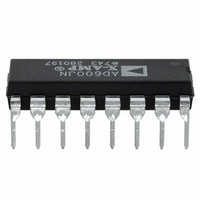AD600JNZ Analog Devices Inc, AD600JNZ Datasheet

AD600JNZ
Specifications of AD600JNZ
Available stocks
Related parts for AD600JNZ
AD600JNZ Summary of contents
Page 1
FEATURES 2 Channels with Independent Gain Control "Linear in dB" Gain Response 2 Gain Ranges: AD600 AD602: – +30 dB Accurate Absolute Gain: 0.3 dB Low Input Noise: 1.4 nV/√Hz Low Distortion: ...
Page 2
AD600/AD602–SPECIFICATIONS +625 mV 500 , and pF, unless otherwise noted. Specifications for the AD600 and AD602 are identical unless otherwise noted Parameter Conditions INPUT CHARACTERISTICS Input Resistance Pins Pins 6 ...
Page 3
ABSOLUTE MAXIMUM RATINGS Supply Voltage ± ± 7 Input ...
Page 4
AD600/AD602–Typical Performance Characteristics 0.45 0.35 0.25 0.15 0.05 –0.05 –0.15 –0.25 –0.35 –0.45 –0.7 –0.5 –0.3 –0.1 0.1 0.3 0.5 0.7 GAIN CONTROL VOLTAGE – V TPC 1. Gain Error vs. Gain Control Voltage 10.0 9.8 9.6 9.4 9.2 9.0 ...
Page 5
TPC 10. Gating Feedthrough to Output, Gating Off to On 500mV 100 200ns TPC 13. Input Stage Overload Recovery Time 10 AD600 20dB 5 AD602 ...
Page 6
AD600/AD602 THEORY OF OPERATION The AD600 and AD602 have the same general design and features. They comprise two fixed gain amplifiers, each pre- ceded by a voltage-controlled attenuator 42.14 dB with independent control interfaces, each having ...
Page 7
The Gain-Control Interface The attenuation is controlled through a differential, high imped- ance (15 MΩ) input, with a scaling factor that is laser trimmed per volt, that is, 31.25 mV/dB. Each of the two amplifiers has its ...
Page 8
AD600/AD602 –40.00dB INPUT 0dB C1HI –0.51dB INPUT 0dB C1HI V = 1.25V C INPUT 0dB C1HI V = 2.5V C Figure 3. AD600 Gain Control Input Calculations for Sequential Control Operation The gains are offset (Figure ...
Page 9
A1 30 COMBINED –10 –0.5 0.0 0.5 1.0 1 Figure 5. Plot of Separate and Overall Gains in Sequential Control –1 –2 –3 ...
Page 10
AD600/AD602 APPLICATIONS The full potential of any high performance amplifier can only be realized by careful attention to details in its applications. The following pages describe fully tested circuits in which many such details have already been considered. However, as ...
Page 11
GAIN-CONTROL VOLTAGE V G – + C1LO C1HI 1 16 A1CM A1HI A1OP A1LO 3 14 – VPOS GAT1 4 13 REF V IN VNEG GAT2 5 12 A2LO A2OP 6 11 – A2 A2CM A2HI ...
Page 12
AD600/AD602 5V R3 46.4k R4 3.74k C1LO 1 A1HI INPUT A1 A1LO 3 – GAT1 4 REF GAT2 5 A2LO 6 – A2 A2HI 7 + C2LO 8 AD600 Figure 15. This Accurate HF AGC Amplifier Uses ...
Page 13
FREQUENCY – MHz Figure 16. AC Response at the Stabilized Output Level of 1.3 V RMS +0.2 0 –0.2 –0.4 0.001 0.01 INPUT AMPLITUDE – V RMS Figure 17. Output Stabilization vs. RMS Input for Sine Wave ...
Page 14
AD600/AD602 CAL 0dB C1LO 1 R1 INPUT 115 A1HI 1V RMS 2 MAX R2 200 (SINE WAVE) A1LO 3 GAT1 4 GAT2 R3 5 133k A2LO 6 A2HI U3A 7 C2LO 1/2 8 AD712 15.625mV/dB 3.01k Figure ...
Page 15
X-AMP. Note that it occurs with a periodicity of 12 dB—twice the separation between the tap points (because of the two cascaded stages –1 –2 –3 –4 –5 ...
Page 16
AD600/AD602 C1LO 1 INPUT A1HI 1V RMS 2 + MAX A1 A1LO (SINE WAVE) 3 – GAT1 4 REF GAT2 5 A2LO 6 – A2 A2HI 7 + C2LO 8 U1 AD600 +5V FB 0.1 F +5V DEC 0.1 F ...
Page 17
INPUT SIGNAL – V RMS Figure 27. Gain Error for Figure 19 without the 2 dB Offset Modification 2.0 1.5 1.0 0.5 0.1 0 ...
Page 18
AD600/AD602 0dB ADJUST C1LO R3 1 R17 200 INPUT 115 A1HI 2 + A1LO 3 – GAT1 4 GAT2 5 A2LO 6 – A2 A2HI 7 + C2LO 8 U1 AD600 +6V FB 0.1 F +6V DEC 0.1 F –6V ...
Page 19
INPUT SIGNAL – V RMS Figure 31. Error Ripple Due to the Individual Gain Functions 400 350 300 250 200 1 10 100 1m ...
Page 20
AD600/AD602 Dimensions shown in inches and (mm) 16-Lead Plastic DIP Package (N-16) 0.785 (19.94) 0.765 (19.43) 0.295 (7.49) 0.745 (18.92) 0.285 (7.24) 0.275 (6.99 0.100 (2.54) BSC 0.015 (0.38) MIN 0.180 (4.57) MAX 0.150 (3.81) 0.130 ...
Page 21
Revision History Location 3/04—Data Sheet changed from REV REV. D. Changes to SPECIFICATIONS . . . . . . . . . . . . . . . . . . . . . . . . . ...
Page 22
–22– ...
Page 23
–23– ...
Page 24
–24– ...













